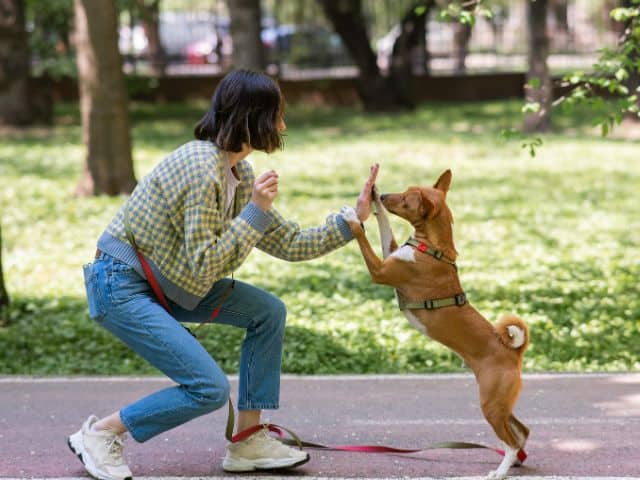Thinking of turning your passion for dogs into a career? Starting a dog walking business in Australia is a rewarding and flexible way to work with animals every day.
According to the 2024 Household, Income and Labour Dynamics in Australia Survey (HILDA), approximately 64% of Australians live in a household with at least one pet. Dogs remain the most popular choice, with around 71% of pet owners owning a dog. That equates to about 46% of the total population having a dog!
It’s clear that, with so many owners of man’s best friend and more people treating their pets more like their babies or children, dog walking can be lucrative. If you dream of working with animals and are looking for a fulfilling, well-paying career caring for them, you should perhaps consider starting a dog walking business or service. However, getting started is no walk in the park, so how can you get your foot in the door? Easy! “Paws” what you are doing and read our helpful tips on how to start a dog walking company in Australia.
Carry Out Your Research Into The Business
Before you start caring for your clients’ furry friends, finding more information about the business is crucial. Market research is all about collecting accurate and helpful information about the dog walking business and the potential customers who may require your services. The goal of this research is to establish the facts on which you will base your business decisions. You could take time out to talk to other walkers in your area or people working in pet-related businesses about your concepts. You could also speak to a few dog owners to get a feel for the potential of your proposed business. With proper planning and sound data, you will attract more customers.
Put Together A Business Plan for a Dog Walking Service
A successful business starts with understanding your local market, the financial requirements, and the potential for your business, then crystallising it into a plan of action. You should consider:
- The services you should offer
- Businesses that can refer to you
- The number of clients you can handle each week
The other important part of your business plan is the financials section, which contains your costs, expenses and income projections to help you predict your profits. Using your competitor analysis and market research, you can easily find out how much other walkers charge for their services per dog in your area so that you can set your fees accordingly.
Study a qualification with a focus on Animal Care!
Although undercutting the cheapest dog walker in your area is an option, you should not view it as your sole option. Use your market research to establish what your potential clients are looking for. You might find that offering shorter walks for a group of dogs is acceptable to your audience, or you might be in an affluent area with people willing to pay top dollar for longer, solo walks and added services like grooming. Establishing the state of the market, your costs and your revenue projections will help you prepare a game plan for your dog walking business, set your budget and give you realistic expectations of what you can earn. Once you are satisfied that a dog walking job is for you, you can register a business name and set up an ABN and open a bank account. The Australian Government Business portal is a great resource to help you get started.

Create An Operational Framework For Your Dog Walking Business
Your framework covers all the operatives of your business plan. It examines your customers’ needs, what services you plan to provide, how you will sell your service and a way to bring these parts together to create a successful, profitable business. Answering the following frequently asked questions from dog owners will give you a starting point:
- How much experience do you have with dogs?
- Can you provide first aid medical care if needed?
- What happens if my dog needs treatment while in your care?
- Do you have a qualification in animal care or behaviour?
- Where will you walk my dog?
- My dog has a behavioural issue (e.g., aggression towards other dogs). When he/she is on the lead, can you handle him/her?
- Can you train my dog?
- Can you walk and look after (e.g., feed) my dog if I go on holiday?
- Can you walk more than one dog at a time?
- How and when will I pay you?
- Can I have a receipt for your services?
- Do you have police clearance?
Take particular note of the required insurances including public liability cover

Promote And Grow Your Dog Walking Business
Every successful dog walker in Australia understands how essential marketing is to the success and longevity of their business. In any case, most people can walk their dogs, so your challenge is to find, maintain and grow your client base and convince them to sign up. Fortunately, there are effective online and offline local marketing strategies that are not only affordable but also highly effective:
- Set up a website to show off your qualifications, experience and love for dogs
- Create social media profiles
- List your services on reputable dog sitting and dog walking listing pages and reach out to owners who are seeking services in your local areas.
- Potential referrals from other pet-related businesses
- Networking opportunities e.g., www.piaa.net.au
- Encourage referrals e.g., referral discounts
- Offers for new clients
- Loyalty packages
- Spread the word in your community by attending local events, markets
- Flyers and mailbox drop
- Local Facebook community groups
- Gumtree
- Social media advertising
- Encourage existing clients to leave reviews on Google and Facebook
How Much Do Dog Walkers Earn?
Pet care spending is at an all-time high. With many dog owners working long hours or managing busy schedules, dog walking has become an essential service.
The average Aussie dog is walked about 9 times a week, for around 30 minutes per walk. In many areas, people are willing to pay a premium for reliable, safe, and qualified care for their dogs.
In 2025, dog walkers in Australia can typically expect to earn between $30 and $70 per walk, depending on factors like walk duration, whether it’s a group or private session and the dog’s behaviour. Group walks for 30 to 45 minutes often range from $30 to $45, while private walks of an hour can fetch upwards of $70. Extra dogs usually add $10–$25 to the total cost, and specialised services for reactive dogs may be priced higher.
If you’re a qualified dog trainer, such as someone who has completed AVT’s Certificate IV in Animal Behaviour and Training, you can also offer walk-and-train services. These are typically priced between $70 and $120 per session depending on length and complexity. These sessions combine exercise with tailored behavioural training, making them a valuable option for clients with dogs needing extra guidance.
Sources: Airtasker, MadPaws
Walking dogs: Jobs for Dog Walkers
If you want the flexibility of becoming a dog walker but are not yet ready to set up your own business, it is possible to work for others. This is an excellent way to obtain experience but also make sure the career path as a dog walker is for you.
There are two ways you can get a job as a dog walker:
- Work for an organisation hiring dog walkers. An example of businesses that hire dog walkers includes rescue organisations and boarding kennels.
- By signing up for online job matching services such as MadPaws, Pawshake and PetCloud. This is a low-risk option if you wish to start working as a dog walker without the hassle of setting up a business (of course, depending on your personal circumstances) and if you want the flexibility of setting your own hours.
What Qualifications Do I Need To Be A Dog Walker?
As a business owner, you will need some skills in business administration and marketing to run your business. Clients are also more likely to be attracted to businesses that employ or have individuals who have completed formal training in animal care, so they know their pets are in the best hands. Consider studying:
ACM20121 Certificate II in Animal Care: A great entry-level course covering handling, behaviour and health.
ACM30122 Certificate III in Animal Care Services: For more advanced knowledge and practical skills.
ACM40322 Certificate IV in Animal Behaviour and Training: Ideal for established dog walkers who want to advance their skills and offer walk-and-train packages.
This will give your clients the peace of mind that you have the knowledge to handle and care for their loved ones when they are in your care. Contact us to learn more.

Courses you may like
On-Site Intensive
ACM20121 Certificate II in Animal Care (Health & Welfare)
Dogs' Refuge & Cat Haven Program
Animal Health & Welfare
Online
ACM20121 Certificate II in Animal Care (Online)
Study Online









